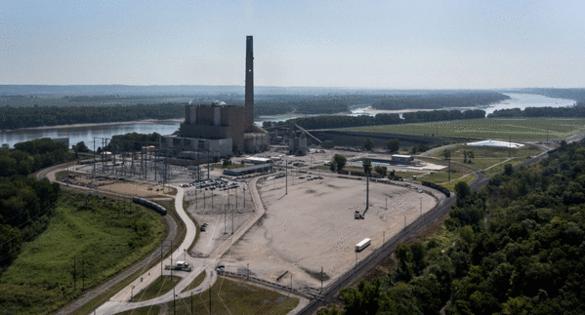Can Ameren's newly shuttered coal plant in Missouri find new life? Other coal sites have
Published in Business News
Ameren’s second-largest coal plant has put its last electricity onto the grid and emitted its final plumes of air pollution, which has fueled a years-long court battle — a conflict that is still unresolved, as parties weigh how the St. Louis-based utility should pay for the harm caused.
But after its closure earlier this month, the Rush Island plant in Jefferson County, Missouri, leaves more than a lingering court case in its wake. There are also questions about how the local community will be affected by the move and the loss of 90 jobs, and what will happen to the site as it joins other shuttered coal plants around the country.
Some of those sites have languished as vacant properties, while others have given rise to new uses that take advantage of assets such as existing power lines and readymade access to the power grid.
Those attributes can attract interest from new energy projects or power-hungry customers, such as data centers that need to receive electricity in bulk.
Ameren has not said what could become of the 500-acre Rush Island site, leaving the door open for a range of possibilities.
“It’s a site that could potentially have all kinds of different uses in the future,” said Tim Lafser, Ameren’s vice president of power operations and engineering, noting its rail and river access and “connections from the plant that hook it to the grid.”
Industry representatives, real estate professionals and officials in coal-plant communities say the site has plenty of allure for redevelopment.
“I’m sure they’ve received numerous phone calls from different investors and developers about that site. I’d be shocked if they haven’t,” said Steve Zuber, a broker specializing in industrial property at Barber Murphy, a commercial real estate company based in the Metro East. “There’s a lot of interest in that land.”
Residents around Rush Island hope something will take root at the site in its post-coal era — especially since the plant’s demise could mean the loss of $1 million to $1.5 million in tax revenue for local schools without new development.
“We hope there’s a future there,” said David Haug, who lives near the plant and is the superintendent of the Jefferson R-VII School District. “If Ameren doesn’t want to be there, I know there’s interest from other groups to go in. … That property holds value.”
Old sites, new uses
Ameren itself provides a snapshot of what can await former coal plants.
At the site of its former Meramec Energy Center, in south St. Louis County, Missouri, the company has proposed building a natural gas plant to help shoulder electricity demand when it spikes, especially during extreme winter weather.
The proposal is before utility regulators with the Missouri Public Service Commission. PSC staff members are among those expressing support for the project, while critics question the reliability and affordability of gas generation, on top of its greenhouse gas emissions.
Across the Mississippi River, Illinois offers more examples of coal plant sites that are being transformed, including at sites once owned by Ameren before the company sold them.
Officials at Vistra, a Texas-based utility that owns coal plants across Illinois, say they want to install new forms of generation at some of the old Ameren sites, whatever the fuel source may be — with options like solar, batteries and small, new-age nuclear reactors on the table.
The company has already begun the construction of solar projects in Illinois, on its Baldwin and Coffeen coal plant sites, and is soon to begin building a third at its Newton plant. Two are expected to be operational by the end of the year.
“These sites are ideal because there’s already interconnections, infrastructure, land permitting. ... A lot of those steps are already taken care of,” said Meranda Cohn, a spokeswoman for Vistra.
She noted that Illinois has enacted incentives for clean energy that help spur investment in technologies like solar and batteries but said the company is “always hopeful” projects can work without some kind of subsidy.
‘Get by and pay the bills’
But converting coal plants to new uses can be difficult, expensive, slow and plagued with years of false starts or inactivity.
For instance, in Meredosia, Illinois — about two hours north of St. Louis — a sizable chunk of a former Ameren coal plant site on the Illinois River is still on the market more than a decade after the facility stopped running. Barber Murphy, the site’s realtor, is advertising “negotiable” sale prices and lease rates.
The site was targeted by the U.S. Department of Energy for a $1.7 billion carbon capture project that would have piped the plant’s greenhouse gas emissions deep underground. But it failed to attract enough private investment, despite the federal government investing $1 billion at the site.
Zuber, one of the brokers for the site, said a portion of the land has been under contract to an energy storage company. But after a couple of years, the company still has not closed on the deal while doing due diligence and navigating state-level permitting, which Zuber said can take three to five years.
He added that, while every power plant site is unique, they “happen to have some features that make it interesting to a lot of different companies.”
For the town of Meredosia, the plant’s shutdown has meant more than a loss of revenue and 130 jobs. The closure has sapped economic vitality in other ways. Former employees and the businesses they once supported also left, helping drive down the value of property and associated tax revenue.
“There’s nobody there working, so nobody’s gonna come in and buy a home,” said Ernie Gregory, a village trustee.
After years of inaction at the site and stalled hopes for its redevelopment, residents aren’t holding their breath for change.
“I’d take anything right now that employed 50 people or more,” Gregory said.
In some places where old coal plant sites are getting converted to other uses, local leaders say new energy projects that “piggyback” on existing transmission lines are a civic boon — even if they can’t fully replace what has closed down, in terms of electrical output or revenue.
“It would be great to continue to export energy,” said Jason Warfel, chairman of the Jasper County Board, where Vistra’s Newton plant is located. “For our rural community, it definitely helps the tax base and the tax burden.”
Still, some towns are left confronting big fiscal challenges and uncertain futures. Next to its retired coal plant that is welcoming a nearly finished solar facility, the town of Coffeen is on the hook for upgrades to its sewer system, which was installed around the same time as the plant, in the 1960s.
The cost is more than the town of 650 residents can muster, leading it to seek $1 million in grant money to help foot the bill, said Mayor Robert Wessel. He worked at the coal plant for decades before retiring in 2019, just ahead of the facility’s closure.
“It makes it tough,” said Wessel. “It’s an older generation here. … We’re just kind of trying to get by and pay the bills and take care of the infrastructure.”
He estimates the coal plant employed 100 people at the time it closed, and perhaps 250 or more at its peak. He said the solar site may not employ any full-time workers, although he hopes some technicians or other workers can be based there.
“I was hoping they could make that a hub,” said Wessel. “I don’t know if they’ll do that or not.”
‘Not a one-horse town’
At Rush Island, the near-term picture is clear, as Ameren plans to spend the next few months decommissioning the plant — taking apart or removing equipment and preparing the site for demolition. Some of the plant’s 90 workers will spearhead that work, while others have been reassigned to the company’s two coal plants that remain operational.
“We’ve been able to find them all new homes,” Lafser said.
Originally, Ameren moved to offer the area around Rush Island “community transition” funding. The money, though, would have been covered by Ameren customers. The utility requested nearly $3.7 million of such funding when it opted to close the plant, using a complicated financing technique called securitization, newly authorized in Missouri.
But state utility regulators rejected that part of the company’s proposal, saying they didn’t want to subject Ameren’s customers to those costs and noting the site could have a new use in the future.
“Other ratepayers would be paying lost tax revenues to the school district,” Kayla Hahn, chair of the PSC, said at a May meeting. “I’m not sure that’s fair to all the other ratepayers.”
Another commissioner, Jason Holsman, described the decision to reject the funding as an impetus for Ameren to chart a course for the site’s future.
“Figure out what you’re going to do with it that’s going to help that community out,” he said.
Besides what becomes of the site, the plant’s legacy is still being charted in court, in the ongoing case brought against Ameren by the U.S. Department of Justice over the utility’s move to upgrade its generators without proper permits. The modifications improperly extended the plant’s lifespan and allowed it to emit more air pollutants, like sulfur dioxide.
Next month, a hearing will aim to determine if, and how, the company should pay for years of air pollution from the plant — perhaps by providing air filters and electric buses around the region. The hearing is set for Nov. 21.
Whatever happens in court or at the plant site, Haug, of the local school district, is confident things will work out. The district braced for the plant’s retirement the last few years, and he said the loss is countered by population growth in the area from new homes and the existence of other industries, like a cement plant.
“We’ve been fortunate with other growth in the area,” he said, adding that the district has anticipated decreasing revenue as Rush Island operations and the plant’s value have dropped in recent years.
“It’s not a one-horse town and if Ameren closes, that’s it,” he said. “Long term, I don’t see this being a sad story where the schools will collapse.”
©2024 STLtoday.com. Distributed by Tribune Content Agency, LLC.












Comments